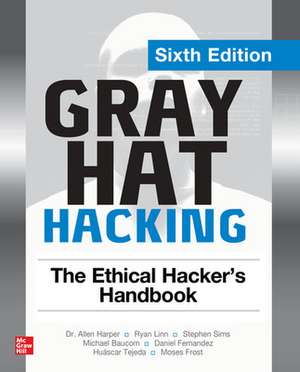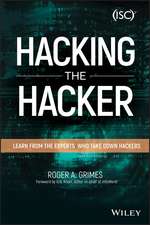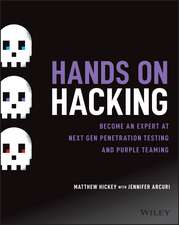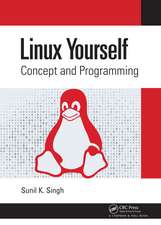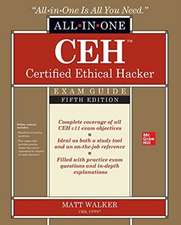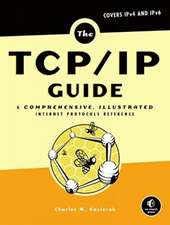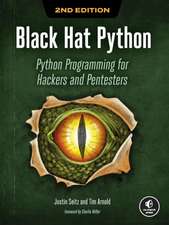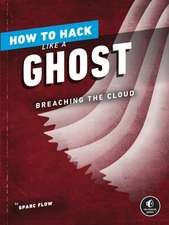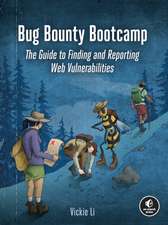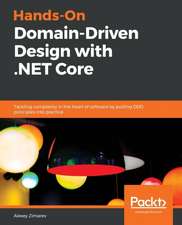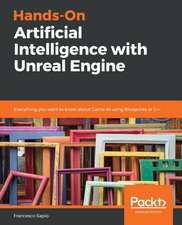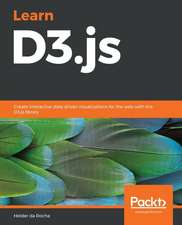Gray Hat Hacking: The Ethical Hacker's Handbook, Sixth Edition
Autor Allen Harper, Ryan Linn, Stephen Sims, Michael Baucom, Huascar Tejeda, Daniel Fernandez, Moses Frosten Limba Engleză Paperback – 29 mar 2022
This fully updated, industry-standard security resource shows, step by step, how to fortify computer networks by learning and applying effective ethical hacking techniques. Based on curricula developed by the authors at major security conferences and colleges, the book features actionable planning and analysis methods as well as practical steps for identifying and combating both targeted and opportunistic attacks.
Gray Hat Hacking: The Ethical Hacker's Handbook, Sixth Edition clearly explains the enemy’s devious weapons, skills, and tactics and offers field-tested remedies, case studies, and testing labs. You will get complete coverage of Internet of Things, mobile, and Cloud security along with penetration testing, malware analysis, and reverse engineering techniques. State-of-the-art malware, ransomware, and system exploits are thoroughly explained.
- Fully revised content includes 7 new chapters covering the latest threats
- Includes proof-of-concept code stored on the GitHub repository
- Authors train attendees at major security conferences, including RSA, Black Hat, Defcon, and B-Sides
Preț: 270.97 lei
Preț vechi: 338.72 lei
-20% Nou
Puncte Express: 406
Preț estimativ în valută:
51.86€ • 53.94$ • 42.81£
51.86€ • 53.94$ • 42.81£
Carte disponibilă
Livrare economică 24 martie-07 aprilie
Livrare express 08-14 martie pentru 58.41 lei
Preluare comenzi: 021 569.72.76
Specificații
ISBN-13: 9781264268948
ISBN-10: 1264268947
Pagini: 704
Dimensiuni: 234 x 190 x 44 mm
Greutate: 1.18 kg
Ediția:6
Editura: McGraw Hill Education
Colecția McGraw-Hill
Locul publicării:United States
ISBN-10: 1264268947
Pagini: 704
Dimensiuni: 234 x 190 x 44 mm
Greutate: 1.18 kg
Ediția:6
Editura: McGraw Hill Education
Colecția McGraw-Hill
Locul publicării:United States
Cuprins
Preface
Acknowledgments
Introduction
Part I. Preparation
Chapter 1. Gray Hat Hacking
Gray Hat Hacking Overview
History of Hacking
Ethics and Hacking
Definition of Gray Hat Hacking
History of Ethical Hacking
History of Vulnerability Disclosure
Bug Bounty Programs
Know the Enemy: Black Hat Hacking
Advanced Persistent Threats
Lockheed Martin Cyber Kill Chain
Courses of Action for the Cyber Kill Chain
MITRE ATT&CK Framework
Summary
For Further Reading
References
Chapter 2. Programming Survival Skills
C Programming Language
Basic C Language Constructs
Lab 2-1: Format Strings
Lab 2-2: Loops
Lab 2-3: if/else
Sample Programs
Lab 2-4: hello.c
Lab 2-5: meet.c
Compiling with gcc
Lab 2-6: Compiling meet.c
Computer Memory
Random Access Memory
Endian
Segmentation of Memory
Programs in Memory
Buffers
Strings in Memory
Pointers
Putting the Pieces of Memory Together
Lab 2-7: memory.c
Intel Processors
Registers
Assembly Language Basics
Machine vs. Assembly vs. C
AT&T vs. NASM
Addressing Modes
Assembly File Structure
Lab 2-8: Simple Assembly Program
Debugging with gdb
gdb Basics
Lab 2-9: Debugging
Lab 2-10: Disassembly with gdb
Python Survival Skills
Getting Python
Lab 2-11: Launching Python
Lab 2-12: “Hello, World!” in Python
Python Objects
Lab 2-13: Strings
Lab 2-14: Numbers
Lab 2-15: Lists
Lab 2-16: Dictionaries
Lab 2-17: Files with Python
Lab 2-18: Sockets with Python
Summary
For Further Reading
References
Chapter 3. Linux Exploit Development Tools
Binary, Dynamic Information-Gathering Tools
Lab 3-1: Hello.c
Lab 3-2: ldd
Lab 3-3: objdump
Lab 3-4: strace
Lab 3-5: ltrace
Lab 3-6: checksec
Lab 3-7: libc-database
Lab 3-8: patchelf
Lab 3-9: one_gadget
Lab 3-10: Ropper
Extending gdb with Python
Pwntools CTF Framework and Exploit Development Library
Summary of Features
Lab 3-11: leak-bof.c
HeapME (Heap Made Easy) Heap Analysis and Collaboration Tool
Installing HeapME
Lab 3-12: heapme_demo.c
Summary
For Further Reading
References
Chapter 4. Introduction to Ghidra
Creating Our First Project
Installation and QuickStart
Setting the Project Workspace
Functionality Overview
Lab 4-1: Improving Readability with Annotations
Lab 4-2: Binary Diffing and Patch Analysis
Summary
For Further Reading
References
Chapter 5. IDA Pro
Introduction to IDA Pro for Reverse Engineering
What Is Disassembly?
Navigating IDA Pro
IDA Pro Features and Functionality
Cross-References (Xrefs)
Function Calls
Proximity Browser
Opcodes and Addressing
Shortcuts
Comments
Debugging with IDA Pro
Summary
For Further Reading
References
Part II. Ethical Hacking
Chapter 6. Red and Purple Teams
Introduction to Red Teams
Vulnerability Scanning
Validated Vulnerability Scanning
Penetration Testing
Threat Simulation and Emulation
Purple Team
Making Money with Red Teaming
Corporate Red Teaming
Consultant Red Teaming
Purple Team Basics
Purple Team Skills
Purple Team Activities
Summary
For Further Reading
References
Chapter 7. Command and Control (C2)
Command and Control Systems
Metasploit
Lab 7-1: Creating a Shell with Metasploit
PowerShell Empire
Covenant
Lab 7-2: Using Covenant C2
Payload Obfuscation
msfvenom and Obfuscation
Lab 7-3: Obfuscating Payloads with msfvenom
Creating C# Launchers
Lab 7-4: Compiling and Testing C# Launchers
Creating Go Launchers
Lab 7-5: Compiling and Testing Go Launchers
Creating Nim Launchers
Lab 7-6: Compiling and Testing Nim Launchers
Network Evasion
Encryption
Alternate Protocols
C2 Templates
EDR Evasion
Killing EDR Products
Bypassing Hooks
Summary
For Further Reading
Chapter 8. Building a Threat Hunting Lab
Threat Hunting and Labs
Options of Threat Hunting Labs
Method for the Rest of this Chapter
Basic Threat Hunting Lab: DetectionLab
Prerequisites
Lab 8-1: Install the Lab on Your Host
Lab 8-2: Install the Lab in the Cloud
Lab 8-3: Looking Around the Lab
Extending Your Lab
HELK
Lab 8-4: Install HELK
Lab 8-5: Install Winlogbeat
Lab 8-6: Kibana Basics
Lab 8-7: Mordor
Summary
For Further Reading
References
Chapter 9. Introduction to Threat Hunting
Threat Hunting Basics
Types of Threat Hunting
Workflow of a Threat Hunt
Normalizing Data Sources with OSSEM
Data Sources
OSSEM to the Rescue
Data-Driven Hunts Using OSSEM
MITRE ATT&CK Framework Refresher: T1003.002
Lab 9-1: Visualizing Data Sources with OSSEM
Lab 9-2: AtomicRedTeam Attacker Emulation
Exploring Hypothesis-Driven Hunts
Lab 9-3: Hypothesis that Someone Copied a SAM File
Crawl, Walk, Run
Enter Mordor
Lab 9-4: Hypothesis that Someone Other than an Admin Launched PowerShell
Threat Hunter Playbook
Departure from HELK for Now
Spark and Jupyter
Lab 9-5: Automated Playbooks and Sharing of Analytics
Summary
For Further Reading
References
Part III. Hacking Systems
Chapter 10. Basic Linux Exploits
Stack Operations and Function-Calling Procedures
Buffer Overflows
Lab 10-1: Overflowing meet.c
Ramifications of Buffer Overflows
Local Buffer Overflow Exploits
Lab 10-2: Components of the Exploit
Lab 10-3: Exploiting Stack Overflows from the Command Line
Lab 10-4: Writing the Exploit with Pwntools
Lab 10-5: Exploiting Small Buffers
Exploit Development Process
Lab 10-6: Building Custom Exploits
Summary
For Further Reading
Chapter 11. Advanced Linux Exploits
Lab 11-1: Vulnerable Program and Environment Setup
Lab 11-2: Bypassing Non-Executable Stack (NX) with Return-Oriented Programming (ROP)
Lab 11-3: Defeating Stack Canaries
Lab 11-4: ASLR Bypass with an Information Leak
Lab 11-5: PIE Bypass with an Information Leak
Summary
For Further Reading
References
Chapter 12. Linux Kernel Exploits
Lab 12-1: Environment Setup and Vulnerable procfs Module
Lab 12-2: ret2usr
Lab 12-3: Defeating Stack Canaries
Lab 12-4: Bypassing Supervisor Mode Execution Protection (SMEP) and Kernel Page-Table Isolation (KPTI)
Lab 12-5: Bypassing Supervisor Mode Access Prevention (SMAP)
Lab 12-6: Defeating Kernel Address Space Layout Randomization (KASLR)
Summary
For Further Reading
References
Chapter 13. Basic Windows Exploitation
Compiling and Debugging Windows Programs
Lab 13-1: Compiling on Windows
Debugging on Windows with Immunity Debugger
Lab 13-2: Crashing the Program
Writing Windows Exploits
Exploit Development Process Review
Lab 13-3: Exploiting ProSSHD Server
Understanding Structured Exception Handling
Understanding and Bypassing Common Windows Memory Protections
Safe Structured Exception Handling
Bypassing SafeSEH
Data Execution Prevention
Return-Oriented Programming
Gadgets
Building the ROP Chain
Summary
For Further Reading
References
Chapter 14. Windows Kernel Exploitation
The Windows Kernel
Kernel Drivers
Kernel Debugging
Lab 14-1: Setting Up Kernel Debugging
Picking a Target
Lab 14-2: Obtaining the Target Driver
Lab 14-3: Reverse Engineering the Driver
Lab 14-4: Interacting with the Driver
Token Stealing
Lab 14-5: Arbitrary Pointer Read/Write
Lab 14-6: Writing a Kernel Exploit
Summary
For Further Reading
References
Chapter 15. PowerShell Exploitation
Why PowerShell
Living off the Land
PowerShell Logging
PowerShell Portability
Loading PowerShell Scripts
Lab 15-1: The Failure Condition
Lab 15-2: Passing Commands on the Command Line
Lab 15-3: Encoded Commands
Lab 15-4: Bootstrapping via the Web
Exploitation and Post-Exploitation with PowerSploit
Lab 15-5: Setting Up PowerSploit
Lab 15-6: Running Mimikatz Through PowerShell
Using PowerShell Empire for C2
Lab 15-7: Setting Up Empire
Lab 15-8: Staging an Empire C2
Lab 15-9: Using Empire to Own the System
Lab 15-10: Using WinRM to Launch Empire
Summary
For Further Reading
Reference
Chapter 16. Getting Shells Without Exploits
Capturing Password Hashes
Understanding LLMNR and NBNS
Understanding Windows NTLMv1 and NTLMv2 Authentication
Using Responder
Lab 16-1: Getting Passwords with Responder
Using Winexe
Lab 16-2: Using Winexe to Access Remote Systems
Lab 16-3: Using Winexe to Gain Elevated Privileges
Using WMI
Lab 16-4: Querying System Information with WMI
Lab 16-5: Executing Commands with WMI
Taking Advantage of WinRM
Lab 16-6: Executing Commands with WinRM
Lab 16-7: Using Evil-WinRM to Execute Code
Summary
For Further Reading
Reference
Chapter 17. Post-Exploitation in Modern Windows Environments
Post-Exploitation
Host Recon
Lab 17-1: Using whoami to Identify Privileges
Lab 17-2: Using Seatbelt to Find User Information
Lab 17-3: System Recon with PowerShell
Lab 17-4: System Recon with Seatbelt
Lab 17-5: Getting Domain Information with PowerShell
Lab 17-6: Using PowerView for AD Recon
Lab 17-7: Gathering AD Data with SharpHound
Escalation
Lab 17-8: Profiling Systems with winPEAS
Lab 17-9: Using SharpUp to Escalate Privileges
Lab 17-10: Searching for Passwords in User Objects
Lab 17-11: Abusing Kerberos to Gather Credentials
Lab 17-12: Abusing Kerberos to Escalate Privileges
Active Directory Persistence
Lab 17-13: Abusing AdminSDHolder
Lab 17-14: Abusing SIDHistory
Summary
For Further Reading
Chapter 18. Next-Generation Patch Exploitation
Introduction to Binary Diffing
Application Diffing
Patch Diffing
Binary Diffing Tools
BinDiff
turbodiff
Lab 18-1: Our First Diff
Patch Management Process
Microsoft Patch Tuesday
Obtaining and Extracting Microsoft Patches
Summary
For Further Reading
References
Part IV. Hacking IoT
Chapter 19. Internet of Things to Be Hacked
Internet of Things (IoT)
Types of Connected Things
Wireless Protocols
Communication Protocols
Security Concerns
Shodan IoT Search Engine
Web Interface
Shodan Command-Line Interface
Lab 19-1: Using the Shodan Command Line
Shodan API
Lab 19-2: Testing the Shodan API
Lab 19-3: Playing with MQTT
Implications of this Unauthenticated Access to MQTT
IoT Worms: It Was a Matter of Time
Prevention
Summary
For Further Reading
References
Chapter 20. Dissecting Embedded Devices
CPU
Microprocessor
Microcontrollers
System on Chip
Common Processor Architectures
Serial Interfaces
UART
SPI
I2C
Debug Interfaces
JTAG
SWD
Software
Bootloader
No Operating System
Real-Time Operating System
General Operating System
Summary
For Further Reading
References
Chapter 21. Exploiting Embedded Devices
Static Analysis of Vulnerabilities in Embedded Devices
Lab 21-1: Analyzing the Update Package
Lab 21-2: Performing Vulnerability Analysis
Dynamic Analysis with Hardware
The Test Environment Setup
Ettercap
Dynamic Analysis with Emulation
FirmAE
Lab 21-3: Setting Up FirmAE
Lab 21-4: Emulating Firmware
Lab 21-5: Exploiting Firmware
Summary
For Further Reading
References
Chapter 22. Software-Defined Radio
Getting Started with SDR
What to Buy
Not So Quick: Know the Rules
Learn by Example
Search
Capture
Replay
Analyze
Preview
Execute
Summary
For Further Reading
Part V. Hacking Hypervisors
Chapter 23. Hypervisors 101
What Is a Hypervisor?
Popek and Goldberg Virtualization Theorems
Goldberg’s Hardware Virtualizer
Type-1 and Type-2 VMMs
x86 Virtualization
Dynamic Binary Translation
Ring Compression
Shadow Paging
Paravirtualization
Hardware Assisted Virtualization
VMX
EPT
Summary
References
Chapter 24. Creating a Research Framework
Hypervisor Attack Surface
The Unikernel
Lab 24-1: Booting and Communication
Lab 24-2: Communication Protocol
Boot Message Implementation
Handling Requests
The Client (Python)
Communication Protocol (Python)
Lab 24-3: Running the Guest (Python)
Lab 24-4: Code Injection (Python)
Fuzzing
The Fuzzer Base Class
Lab 24-5: IO-Ports Fuzzer
Lab 24-6: MSR Fuzzer
Lab 24-7: Exception Handling
Fuzzing Tips and Improvements
Summary
References
Chapter 25. Inside Hyper-V
Environment Setup
Hyper-V Architecture
Hyper-V Components
Virtual Trust Levels
Generation-1 VMs
Lab 25-1: Scanning PCI Devices in a Generation-1 V
Acknowledgments
Introduction
Part I. Preparation
Chapter 1. Gray Hat Hacking
Gray Hat Hacking Overview
History of Hacking
Ethics and Hacking
Definition of Gray Hat Hacking
History of Ethical Hacking
History of Vulnerability Disclosure
Bug Bounty Programs
Know the Enemy: Black Hat Hacking
Advanced Persistent Threats
Lockheed Martin Cyber Kill Chain
Courses of Action for the Cyber Kill Chain
MITRE ATT&CK Framework
Summary
For Further Reading
References
Chapter 2. Programming Survival Skills
C Programming Language
Basic C Language Constructs
Lab 2-1: Format Strings
Lab 2-2: Loops
Lab 2-3: if/else
Sample Programs
Lab 2-4: hello.c
Lab 2-5: meet.c
Compiling with gcc
Lab 2-6: Compiling meet.c
Computer Memory
Random Access Memory
Endian
Segmentation of Memory
Programs in Memory
Buffers
Strings in Memory
Pointers
Putting the Pieces of Memory Together
Lab 2-7: memory.c
Intel Processors
Registers
Assembly Language Basics
Machine vs. Assembly vs. C
AT&T vs. NASM
Addressing Modes
Assembly File Structure
Lab 2-8: Simple Assembly Program
Debugging with gdb
gdb Basics
Lab 2-9: Debugging
Lab 2-10: Disassembly with gdb
Python Survival Skills
Getting Python
Lab 2-11: Launching Python
Lab 2-12: “Hello, World!” in Python
Python Objects
Lab 2-13: Strings
Lab 2-14: Numbers
Lab 2-15: Lists
Lab 2-16: Dictionaries
Lab 2-17: Files with Python
Lab 2-18: Sockets with Python
Summary
For Further Reading
References
Chapter 3. Linux Exploit Development Tools
Binary, Dynamic Information-Gathering Tools
Lab 3-1: Hello.c
Lab 3-2: ldd
Lab 3-3: objdump
Lab 3-4: strace
Lab 3-5: ltrace
Lab 3-6: checksec
Lab 3-7: libc-database
Lab 3-8: patchelf
Lab 3-9: one_gadget
Lab 3-10: Ropper
Extending gdb with Python
Pwntools CTF Framework and Exploit Development Library
Summary of Features
Lab 3-11: leak-bof.c
HeapME (Heap Made Easy) Heap Analysis and Collaboration Tool
Installing HeapME
Lab 3-12: heapme_demo.c
Summary
For Further Reading
References
Chapter 4. Introduction to Ghidra
Creating Our First Project
Installation and QuickStart
Setting the Project Workspace
Functionality Overview
Lab 4-1: Improving Readability with Annotations
Lab 4-2: Binary Diffing and Patch Analysis
Summary
For Further Reading
References
Chapter 5. IDA Pro
Introduction to IDA Pro for Reverse Engineering
What Is Disassembly?
Navigating IDA Pro
IDA Pro Features and Functionality
Cross-References (Xrefs)
Function Calls
Proximity Browser
Opcodes and Addressing
Shortcuts
Comments
Debugging with IDA Pro
Summary
For Further Reading
References
Part II. Ethical Hacking
Chapter 6. Red and Purple Teams
Introduction to Red Teams
Vulnerability Scanning
Validated Vulnerability Scanning
Penetration Testing
Threat Simulation and Emulation
Purple Team
Making Money with Red Teaming
Corporate Red Teaming
Consultant Red Teaming
Purple Team Basics
Purple Team Skills
Purple Team Activities
Summary
For Further Reading
References
Chapter 7. Command and Control (C2)
Command and Control Systems
Metasploit
Lab 7-1: Creating a Shell with Metasploit
PowerShell Empire
Covenant
Lab 7-2: Using Covenant C2
Payload Obfuscation
msfvenom and Obfuscation
Lab 7-3: Obfuscating Payloads with msfvenom
Creating C# Launchers
Lab 7-4: Compiling and Testing C# Launchers
Creating Go Launchers
Lab 7-5: Compiling and Testing Go Launchers
Creating Nim Launchers
Lab 7-6: Compiling and Testing Nim Launchers
Network Evasion
Encryption
Alternate Protocols
C2 Templates
EDR Evasion
Killing EDR Products
Bypassing Hooks
Summary
For Further Reading
Chapter 8. Building a Threat Hunting Lab
Threat Hunting and Labs
Options of Threat Hunting Labs
Method for the Rest of this Chapter
Basic Threat Hunting Lab: DetectionLab
Prerequisites
Lab 8-1: Install the Lab on Your Host
Lab 8-2: Install the Lab in the Cloud
Lab 8-3: Looking Around the Lab
Extending Your Lab
HELK
Lab 8-4: Install HELK
Lab 8-5: Install Winlogbeat
Lab 8-6: Kibana Basics
Lab 8-7: Mordor
Summary
For Further Reading
References
Chapter 9. Introduction to Threat Hunting
Threat Hunting Basics
Types of Threat Hunting
Workflow of a Threat Hunt
Normalizing Data Sources with OSSEM
Data Sources
OSSEM to the Rescue
Data-Driven Hunts Using OSSEM
MITRE ATT&CK Framework Refresher: T1003.002
Lab 9-1: Visualizing Data Sources with OSSEM
Lab 9-2: AtomicRedTeam Attacker Emulation
Exploring Hypothesis-Driven Hunts
Lab 9-3: Hypothesis that Someone Copied a SAM File
Crawl, Walk, Run
Enter Mordor
Lab 9-4: Hypothesis that Someone Other than an Admin Launched PowerShell
Threat Hunter Playbook
Departure from HELK for Now
Spark and Jupyter
Lab 9-5: Automated Playbooks and Sharing of Analytics
Summary
For Further Reading
References
Part III. Hacking Systems
Chapter 10. Basic Linux Exploits
Stack Operations and Function-Calling Procedures
Buffer Overflows
Lab 10-1: Overflowing meet.c
Ramifications of Buffer Overflows
Local Buffer Overflow Exploits
Lab 10-2: Components of the Exploit
Lab 10-3: Exploiting Stack Overflows from the Command Line
Lab 10-4: Writing the Exploit with Pwntools
Lab 10-5: Exploiting Small Buffers
Exploit Development Process
Lab 10-6: Building Custom Exploits
Summary
For Further Reading
Chapter 11. Advanced Linux Exploits
Lab 11-1: Vulnerable Program and Environment Setup
Lab 11-2: Bypassing Non-Executable Stack (NX) with Return-Oriented Programming (ROP)
Lab 11-3: Defeating Stack Canaries
Lab 11-4: ASLR Bypass with an Information Leak
Lab 11-5: PIE Bypass with an Information Leak
Summary
For Further Reading
References
Chapter 12. Linux Kernel Exploits
Lab 12-1: Environment Setup and Vulnerable procfs Module
Lab 12-2: ret2usr
Lab 12-3: Defeating Stack Canaries
Lab 12-4: Bypassing Supervisor Mode Execution Protection (SMEP) and Kernel Page-Table Isolation (KPTI)
Lab 12-5: Bypassing Supervisor Mode Access Prevention (SMAP)
Lab 12-6: Defeating Kernel Address Space Layout Randomization (KASLR)
Summary
For Further Reading
References
Chapter 13. Basic Windows Exploitation
Compiling and Debugging Windows Programs
Lab 13-1: Compiling on Windows
Debugging on Windows with Immunity Debugger
Lab 13-2: Crashing the Program
Writing Windows Exploits
Exploit Development Process Review
Lab 13-3: Exploiting ProSSHD Server
Understanding Structured Exception Handling
Understanding and Bypassing Common Windows Memory Protections
Safe Structured Exception Handling
Bypassing SafeSEH
Data Execution Prevention
Return-Oriented Programming
Gadgets
Building the ROP Chain
Summary
For Further Reading
References
Chapter 14. Windows Kernel Exploitation
The Windows Kernel
Kernel Drivers
Kernel Debugging
Lab 14-1: Setting Up Kernel Debugging
Picking a Target
Lab 14-2: Obtaining the Target Driver
Lab 14-3: Reverse Engineering the Driver
Lab 14-4: Interacting with the Driver
Token Stealing
Lab 14-5: Arbitrary Pointer Read/Write
Lab 14-6: Writing a Kernel Exploit
Summary
For Further Reading
References
Chapter 15. PowerShell Exploitation
Why PowerShell
Living off the Land
PowerShell Logging
PowerShell Portability
Loading PowerShell Scripts
Lab 15-1: The Failure Condition
Lab 15-2: Passing Commands on the Command Line
Lab 15-3: Encoded Commands
Lab 15-4: Bootstrapping via the Web
Exploitation and Post-Exploitation with PowerSploit
Lab 15-5: Setting Up PowerSploit
Lab 15-6: Running Mimikatz Through PowerShell
Using PowerShell Empire for C2
Lab 15-7: Setting Up Empire
Lab 15-8: Staging an Empire C2
Lab 15-9: Using Empire to Own the System
Lab 15-10: Using WinRM to Launch Empire
Summary
For Further Reading
Reference
Chapter 16. Getting Shells Without Exploits
Capturing Password Hashes
Understanding LLMNR and NBNS
Understanding Windows NTLMv1 and NTLMv2 Authentication
Using Responder
Lab 16-1: Getting Passwords with Responder
Using Winexe
Lab 16-2: Using Winexe to Access Remote Systems
Lab 16-3: Using Winexe to Gain Elevated Privileges
Using WMI
Lab 16-4: Querying System Information with WMI
Lab 16-5: Executing Commands with WMI
Taking Advantage of WinRM
Lab 16-6: Executing Commands with WinRM
Lab 16-7: Using Evil-WinRM to Execute Code
Summary
For Further Reading
Reference
Chapter 17. Post-Exploitation in Modern Windows Environments
Post-Exploitation
Host Recon
Lab 17-1: Using whoami to Identify Privileges
Lab 17-2: Using Seatbelt to Find User Information
Lab 17-3: System Recon with PowerShell
Lab 17-4: System Recon with Seatbelt
Lab 17-5: Getting Domain Information with PowerShell
Lab 17-6: Using PowerView for AD Recon
Lab 17-7: Gathering AD Data with SharpHound
Escalation
Lab 17-8: Profiling Systems with winPEAS
Lab 17-9: Using SharpUp to Escalate Privileges
Lab 17-10: Searching for Passwords in User Objects
Lab 17-11: Abusing Kerberos to Gather Credentials
Lab 17-12: Abusing Kerberos to Escalate Privileges
Active Directory Persistence
Lab 17-13: Abusing AdminSDHolder
Lab 17-14: Abusing SIDHistory
Summary
For Further Reading
Chapter 18. Next-Generation Patch Exploitation
Introduction to Binary Diffing
Application Diffing
Patch Diffing
Binary Diffing Tools
BinDiff
turbodiff
Lab 18-1: Our First Diff
Patch Management Process
Microsoft Patch Tuesday
Obtaining and Extracting Microsoft Patches
Summary
For Further Reading
References
Part IV. Hacking IoT
Chapter 19. Internet of Things to Be Hacked
Internet of Things (IoT)
Types of Connected Things
Wireless Protocols
Communication Protocols
Security Concerns
Shodan IoT Search Engine
Web Interface
Shodan Command-Line Interface
Lab 19-1: Using the Shodan Command Line
Shodan API
Lab 19-2: Testing the Shodan API
Lab 19-3: Playing with MQTT
Implications of this Unauthenticated Access to MQTT
IoT Worms: It Was a Matter of Time
Prevention
Summary
For Further Reading
References
Chapter 20. Dissecting Embedded Devices
CPU
Microprocessor
Microcontrollers
System on Chip
Common Processor Architectures
Serial Interfaces
UART
SPI
I2C
Debug Interfaces
JTAG
SWD
Software
Bootloader
No Operating System
Real-Time Operating System
General Operating System
Summary
For Further Reading
References
Chapter 21. Exploiting Embedded Devices
Static Analysis of Vulnerabilities in Embedded Devices
Lab 21-1: Analyzing the Update Package
Lab 21-2: Performing Vulnerability Analysis
Dynamic Analysis with Hardware
The Test Environment Setup
Ettercap
Dynamic Analysis with Emulation
FirmAE
Lab 21-3: Setting Up FirmAE
Lab 21-4: Emulating Firmware
Lab 21-5: Exploiting Firmware
Summary
For Further Reading
References
Chapter 22. Software-Defined Radio
Getting Started with SDR
What to Buy
Not So Quick: Know the Rules
Learn by Example
Search
Capture
Replay
Analyze
Preview
Execute
Summary
For Further Reading
Part V. Hacking Hypervisors
Chapter 23. Hypervisors 101
What Is a Hypervisor?
Popek and Goldberg Virtualization Theorems
Goldberg’s Hardware Virtualizer
Type-1 and Type-2 VMMs
x86 Virtualization
Dynamic Binary Translation
Ring Compression
Shadow Paging
Paravirtualization
Hardware Assisted Virtualization
VMX
EPT
Summary
References
Chapter 24. Creating a Research Framework
Hypervisor Attack Surface
The Unikernel
Lab 24-1: Booting and Communication
Lab 24-2: Communication Protocol
Boot Message Implementation
Handling Requests
The Client (Python)
Communication Protocol (Python)
Lab 24-3: Running the Guest (Python)
Lab 24-4: Code Injection (Python)
Fuzzing
The Fuzzer Base Class
Lab 24-5: IO-Ports Fuzzer
Lab 24-6: MSR Fuzzer
Lab 24-7: Exception Handling
Fuzzing Tips and Improvements
Summary
References
Chapter 25. Inside Hyper-V
Environment Setup
Hyper-V Architecture
Hyper-V Components
Virtual Trust Levels
Generation-1 VMs
Lab 25-1: Scanning PCI Devices in a Generation-1 V
